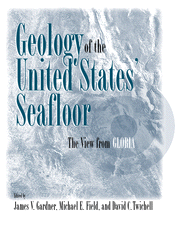Book contents
- Frontmatter
- Contents
- Contributors
- Foreword
- Introduction
- Part I The GLORIA System and Data Processing
- Part II U. S. East Coast EEZ
- Part III Gulf of Mexico and Caribbean EEZ
- Introduction
- 5 Breaching the Levee of a Channel on the Mississippi Fan
- 6 Morphology of Carbonate Escarpments as an Indicator of Erosional Processes
- 7 Sedimentary Processes in the Salt Deformation Province of the Texas-Louisiana Continental Slope
- 8 Sedimentary Processes in a Tectonically Active Region: Puerto Rico North Insular Slope
- 9 A Review of the Tectonic Problems of the Strike-Slip Northern Boundary of the Caribbean Plate and Examination by GLORIA
- Part IV U. S. West Coast EEZ
- Part V Alaskan EEZ
- Index
9 - A Review of the Tectonic Problems of the Strike-Slip Northern Boundary of the Caribbean Plate and Examination by GLORIA
Published online by Cambridge University Press: 25 January 2010
- Frontmatter
- Contents
- Contributors
- Foreword
- Introduction
- Part I The GLORIA System and Data Processing
- Part II U. S. East Coast EEZ
- Part III Gulf of Mexico and Caribbean EEZ
- Introduction
- 5 Breaching the Levee of a Channel on the Mississippi Fan
- 6 Morphology of Carbonate Escarpments as an Indicator of Erosional Processes
- 7 Sedimentary Processes in the Salt Deformation Province of the Texas-Louisiana Continental Slope
- 8 Sedimentary Processes in a Tectonically Active Region: Puerto Rico North Insular Slope
- 9 A Review of the Tectonic Problems of the Strike-Slip Northern Boundary of the Caribbean Plate and Examination by GLORIA
- Part IV U. S. West Coast EEZ
- Part V Alaskan EEZ
- Index
Summary
Introduction
The Caribbean region, south of Cuba (Figure 9–1A), forms one of the distinct lithospheric plates of the Earth's surface (Case and Holcombe 1980). Targets of a scale appropriate for GLORIA imaging are provided by tectonic disruptions of the seafloor along the plate's northern edge. We selected three areas to survey using GLORIA, which allows us to examine the variety of structures produced along this active plate boundary (Figure 9–1B). In the central Cayman Trough, plate motion and geometry cause extension, which creates a short spreading axis that is not connected to the world rift system; GLORIA is used to analyze the crustal structures that are created. Off northwestern Hispaniola, an irregularity in the plate boundary results in compressional motion, and GLORIA is used to analyze the accretionary wedge that is formed by sediments that are scraped off the North American Plate as it is forced against the Caribbean Plate. North of Puerto Rico, the plates appear to slide past each other with neither compression nor extension, yet, surprisingly, a major oceanic trench exists, which exhibits the world's greatest negative free-air gravity anomaly. Structural trends displayed by GLORIA and earthquake distribution are used to hypothesize the plate interactions that form the trench and analyze the response at a corner of a plate (the North American Plate) that is being overrun by another plate (the Caribbean Plate).
Tectonic setting of the Caribbean Plate
The Caribbean Plate is marked by clearly defined subduction zones to its east and west (Figure 9–1B).
- Type
- Chapter
- Information
- Geology of the United States' SeafloorThe View from GLORIA, pp. 135 - 164Publisher: Cambridge University PressPrint publication year: 1996

